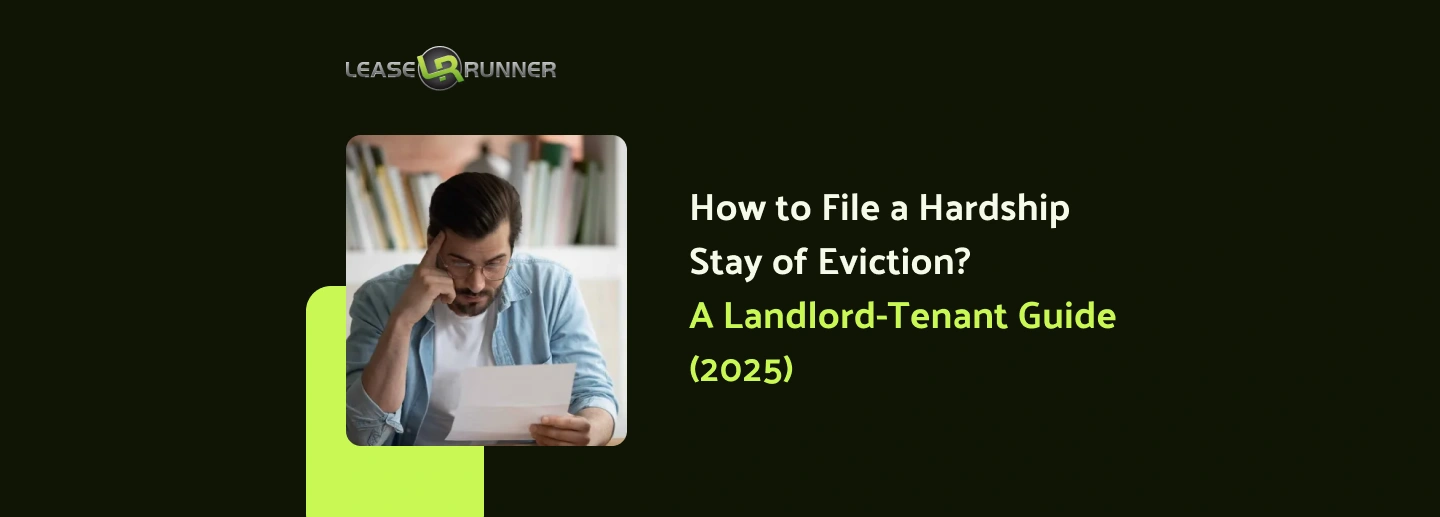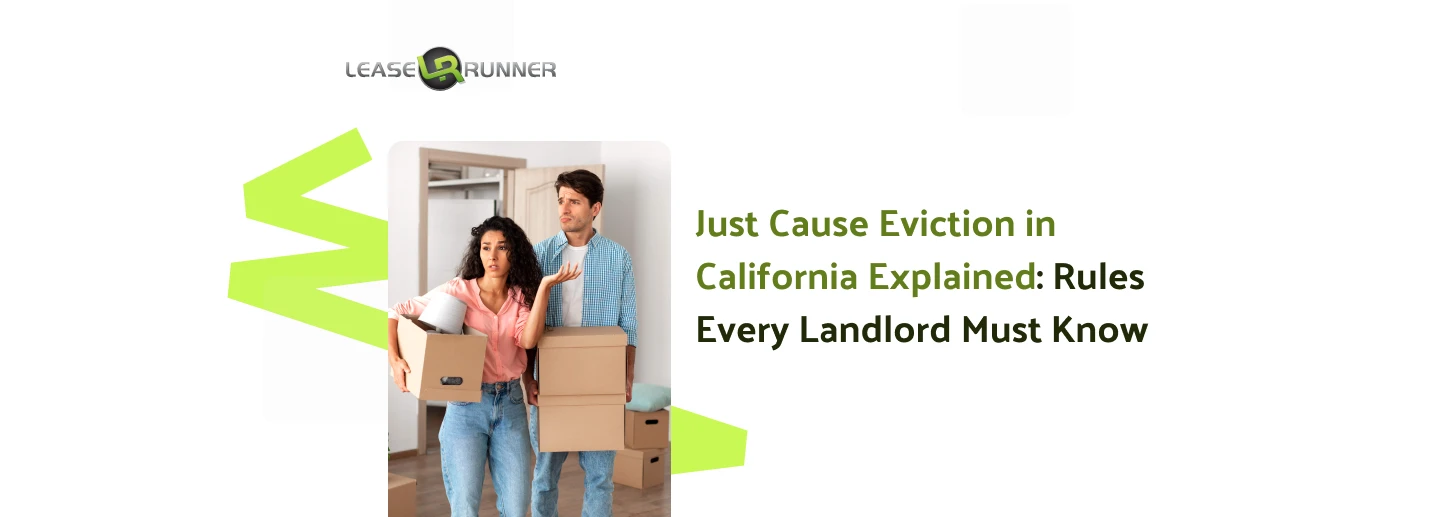Knowing how to file a hardship stay of eviction or how to check the eviction history can protect families from losing their homes when unexpected financial hardships—like job loss or medical emergencies—strike. While many tenants face situations beyond their control, these rules provide short-term relief and still respect the legal rights of property owners.
Courts use established laws to balance the needs of tenants with the rights of landlords, making it essential to follow the correct filing steps, gather the right paperwork, and meet all deadlines.
Through this guide, LeaseRunner offers guidance and resources to help both landlords and tenants navigate these challenges with confidence and clarity. Don’t hesitate any longer, join us now to check if your prospective tenant is going through an eviction!

Highlight of Hardship Stay For Eviction in Key Areas
What Is a Hardship Stay of Eviction?
A hardship stay of eviction is a lawful way for a court to put off carrying out an eviction order for a short time. This stay is meant to provide a renter some "breathing room" after going through an unexpected, major catastrophe that they couldn't manage.
These are key characteristics you need to know about hardship stay:
- It's a Delay, Not a Dismissal: The stay doesn't end the eviction; it only pushes it back.
- It Needs Proof: You need to provide unambiguous proof of your difficulties, such as medical bills or a letter saying you were fired.
- It's not automatic: you have to make a formal request with the court to be evaluated.
Some examples of difficulties that qualify are:
- A sudden loss of a job or a big drop in income.
- A major medical emergency that costs a lot of money that you didn't prepare for.
- The sudden death of the main breadwinner in a family.
- Situations that happen because of domestic abuse.
- Being forced to move or losing money because of a natural catastrophe.
It's important to know that a hardship stay is not an automatic entitlement; you have to ask for it in writing and get a judge's approval. Tenants can't just assume they're safe; they have to file a motion and provide strong proof.
This legal method is meant to find a middle ground between the serious effects of a tenant having to move out right away and a landlord's basic property rights. It offers an organized and temporary way to get help.

What Should Be Included In A Hardship Letter For Eviction?
A well-written hardship letter for eviction is the most important part of a successful request for a stay of eviction since it gives the court important information and shows that you are credible.
An honest and precise letter that clearly explains the date of the difficulty, how it affects your capacity to pay rent, and the good-faith steps you are taking to fix the problem is very persuasive. Because of it, your letter should always include these important parts:
- Complete Identifying Information: Your full name, rental address, and the court case number.
- Specific Hardship Details: Clearly describe the hardship (e.g., job loss, medical emergency), including the date it occurred and its direct impact.
- Supporting Financial Documentation: Provide paperwork that supports your claims about your financial situation.
- Evidence of Resolution Efforts: Include proof of job searches, applications for assistance, or other steps you've taken.
- A Clear Request: State the specific relief you are seeking, such as a 60-day stay to relocate or a temporary payment plan.
Vague statements are ineffective. You must provide concrete evidence to substantiate your claims. For example, medical records, termination letters from an employer, or benefit statements from a government agency are far more powerful than descriptions alone.
Maintain a professional and respectful tone throughout the letter; avoid emotional or confrontational language, as this can undermine your credibility.
Finally, strengthen your case by attaching copies of all relevant supporting documents, such as pay stubs, medical bills, or correspondence with your landlord, to create a complete and compelling narrative for the court.
Where to Get an Eviction Hardship Extension Form?
You need the right form to ask for extra time, and you can generally get it online, write an eviction notice yourself, or in the courts. Also, if you don't comprehend that, legal aid organizations may help you finish it.
Sample Hardship Stay Letter
Basic template helps tenants structure formal court requests:
[Date]
Honorable Judge [Name] [Court Name and Address]
Re: Request for Hardship Stay of Eviction Case Number: [Case Number] Property Address: [Rental Property Address]
Dear Honorable Judge [Name],
I respectfully request a hardship stay of eviction. The reason is [specific hardship - job loss/medical emergency/family crisis]. On [date], I [describe the event that caused hardship]. Unexpected problems have temporarily impacted my ability for rent payments.
I have [describe efforts made - applied for assistance/sought employment/medical treatment]. I request [specific relief - 60 days to relocate/payment plan arrangement] to resolve problems.
Attached please find [list of supporting documents]. I respectfully ask for consideration of the hardship stay request.
Sincerely, [Tenant Name and Signature]
Court Websites & Legal Aid Resources
Getting advice from a professional will help you fill out your documents correctly and make sure you follow all the regulations of the court. Most state court systems include eviction hardship extension forms on their official websites. These forms are standard and made to match local legal criteria, which makes it more likely that you will fill them out properly.
So, utilizing the correct paperwork for your state can help you follow all of the rules in your area. Across the nation, legal aid groups like Legal Aid DC and Cook County Legal Aid help renters who meet certain criteria for free.
Many state bar organizations also have pro bono programs, and most courts have self-help facilities where professional personnel may assist you in filling out forms.
- You may discover useful web resources like these:
- Forms that you may get from the court clerk's office
- E-filing technologies to make it simpler to submit
- Details on fee exemptions for renters with modest incomes
- Instructions on how to serve documents properly
County legal aid websites also get new information about regulations, deadlines, and who may get help regularly. LeaseRunner suggests that both landlords and renters read these local resources to be up to date and ready.

When Can You File a Hardship Stay of Eviction?
Timing is crucial, so file as soon as possible because courts have strict deadlines, and missing them can jeopardize your chances.
Key Filing Windows for Tenants
Understanding and meeting deadlines is essential to avoid missing your chance for legal protection. The process for filing a hardship stay of eviction has strict timing requirements, which can vary by state or local court. Here’s what you need to know:
- After receiving an eviction notice: Tenants usually have a limited window to respond or file a request—often just 5 to 30 days, depending on state law.
- After a court judgment: The window to act may shrink to as little as 3 to 10 days before enforcement begins in most jurisdictions.
- Before enforcement: Tenants may sometimes ask for an emergency eviction hardship extension immediately before enforcement, but it's far less likely that they will get it at this point.
Important advice:
- Last-minute petitions are far less likely to be granted by courts since they are generally perceived as attempts to postpone rather than real efforts to address problems.
- Filing early in the permitted time shows good faith and makes it more likely that you will win.
- Get your papers in order ahead of time and act swiftly. The best approach to preserve your rights is to act immediately.

State-Specific Filing Deadlines & Stay Durations
Different states have their own requirements and offer varying levels of protection:
California
- Governed by Code of Civil Procedure Section 918.
- Tenants must file within 5 days of receiving the written notice.
- Fees range from $0 to $435.
- People may stay for up to 40 days.
- During the protection period, courts generally require renters to keep paying rent.
Texas
- Property Code Section 24.0053 covers this.
- Filing must occur within 5 days of the eviction notice.
- Fees are generally under $50.
- Most stays last up to 30 days.
- Tenants must turn in all of their documents that proves they are having a qualifying hardship.
Florida
- Follows Statute 83.232.
- Filing is allowed after judgment but before enforcement.
- Costs vary from $0 to $150.
- In exceptional situations, stays might last up to six months.
- Courts want precise financial records and evidence that you tried your best to collect.
Georgia
- Governed by OCGA § 44-7-56.
- Requests must be filed within 7 days of judgment.
- Most of the time, fees are less than $100.
- Most stays last between 10 and 30 days.
- Courts only look at short-term, not long-term, financial problems.
New York
- Uses Real Property Actions Law Section 749.
- Filing deadlines vary by jurisdiction, but action is usually required within 10 days of judgment.
- Stays can last up to 6 months for qualifying cases.
- Protections are available for both tenants and landlords.
Each state’s process is unique, so it’s important to review local rules and prepare all required documents and payments in advance.
Protect your rental future with smarter screening and management 

Prevent Eviction Stress Before It Starts
How to File a Hardship Stay of Eviction? A Step-by-Step Guide for Tenants
As a tenant, dealing with eviction can be stressful. If you're not sure where to start, that's okay. Here’s a step-by-step guide to help you file a hardship stay of eviction and protect your rights as a tenant.

Step 1: Review Your Eviction Notice and Court Judgment
The steps to file a hardship stay of eviction begin with a thorough paperwork review. Tenants must first identify the type of eviction notice they’ve received, as the legal basis and specific deadlines significantly impact their rights. Different grounds for eviction can also affect whether they qualify for a hardship stay or other legal protections.
Court judgments contain key information:
- Case number and court jurisdiction
- Amount owed and payment deadlines
- Specific enforcement timelines
- Available appeal or motion periods
Understanding the eviction timeline helps identify remaining filing opportunities. Some courts provide automatic stay periods following judgment. Others require immediate action.
Step 2: Gather Supporting Documents
To get an eviction hardship extension, you need to provide compelling proof that clearly illustrates your financial status and the causes for your difficulty.
- Pay stubs, bank statements, and tax returns: To show your income before and after financial hardship began.
- Medical records: To demonstrate health issues that contributed to your situation.
- Employment termination letters: To confirm job loss or reduced working hours.
- Emergency or disaster notifications: To prove involvement in a crisis (e.g., natural disaster, fire, or other emergencies).
- Emergency or disaster notifications: To document crises like natural disasters or accidents.
- Proof of applying for financial assistance, such as rental relief or aid programs.
- Job search records or benefit applications, showing you are actively trying to improve your situation.
- Written communication with your landlord: Including notices about rent or attempts to negotiate.
- Lease agreement and rent payment history: To establish your rental terms and payment efforts.
The court will see that you are taking action if you can prove that you have attempted to fix the situation, including asking for aid or looking for a new place to live. Your hardship request will be stronger if your records are more detailed and well-organized.
Step 3: Complete Required Forms and File with the Court
Fill out the court form clearly and neatly, and make sure to attach all required documents before filing it with the correct court. Depending on your location, you may be able to file online or be required to submit it in person.
After filing, you’ll need to either pay the filing fee or request a fee waiver—courts often offer assistance for low-income individuals, so be prepared to show proof of your income when applying. Don’t forget to give a copy of your filing to your landlord and submit proof of service to the court.
Finally, ask the court clerk for a hearing date to move your request forward.
Step 4: Prepare for Your Hearing
Before your hearing, make sure you have all your important documents ready to bring with you to court .A strong presentation at your hearing can influence the judge’s decision. Preparation is key.
Think about how you’ll explain your story and be prepared to answer the judge’s questions clearly and respectfully. Staying calm and polite will help you get your point across.
If you have a lawyer, talk things over with them in advance. If not, try reaching out to legal aid for advice. It’s also a good idea to practice what you want to say and jot down your main points.
Step 5: After the Hearing
Listen carefully to the judge’s decision. If you are granted the stay, make sure to follow all the court’s instructions, such as paying rent or providing updates if required. If the judge denies your request, ask about the possibility of appealing the decision, as you may still have other options available.
All in all, always stay informed about your next steps to ensure you comply with the court’s orders and protect your rights.

What a Hardship Stay of Eviction Does & Doesn't Do for Renters
A hardship stay of eviction offers renters valuable time, but it is not a complete solution to every problem. Understanding both the benefits and limits of this protection is important.
What Does a Hardship Stay Legally Protect?
When granted, this stay temporarily halts the eviction process, which can prevent families from being forced out of their homes right away. The protection usually lasts between 30 and 180 days, depending on the court and the specific hardship. This additional time gives tenants a chance to deal with their money or personal problems and find solutions.
Key legal protections include
- Temporary housing security: The court injunction protects people from being kicked out of their homes too soon.
- Time to recover: Renters might utilize this time to deal with problems or find a new place to live.
- Opportunities for negotiation: The stay encourages open communication and possible agreements with landlords.
- Enforceable orders: Landlords must follow the court’s decision, and violations can lead to legal penalties.
- Due process: Tenants receive a fair hearing and a chance to present evidence.
An eviction hardship extension is a court order that landlords must follow. If a landlord doesn't follow the stay, they might be charged with contempt or suffer additional consequences. This keeps renters from being kicked out too quickly.
LeaseRunner has learned that when both sides talk to one another and work together to find solutions, things usually turn out better for everyone.
Using the stay period for honest discussion and negotiation can lead to more positive outcomes than fighting in court. The legal framework is designed to protect tenants, encourage cooperation, and ensure fair treatment for all.
Limits Of A Hardship Stay For Renters
A hardship stay may help a lot in the near term, but it does have certain apparent limits:
- You are still responsible for paying all of your rent; the stay does not erase your debt or pardon missing payments.
- The protection only lasts for a short time. If the problem isn't fixed by that time, the eviction procedure might proceed.
- Eviction records stay on your rental history, which might make it harder for you to rent in the future.
- You have to submit and provide proof to support your motion; the court will not automatically issue a stay.
- You can't utilize the same hardship again and again without fresh and acceptable reasons. It doesn't cover future money troubles.
Tenants must show that they have real, fresh problems every time they petition the courts. If you breach any of the terms of the court or damage the property while you are there, the landlord might petition the court to terminate the protection early or take further legal action.
Landlord-Tenant Rights During a Hardship Stay of Eviction
Both sides have rights and duties during the stay.
Tenant's Rights
Tenants keep these rights:
- Stay at home during the stay
- Safe housing and utilities
- Notice before any hearing
- A chance to speak in court
- Ask for more time if things change
Landlords cannot change locks or turn off power, and they cannot punish tenants for asking for help. If a landlord breaks the rules, tell the court immediately. Don’t forget to keep records of what happens and take some pictures if needed.
Landlord's Rights
Landlords also have a lot of rights at this time:
- The right to start eviction again after the stay ends, as long as all legal steps are taken.
- The capacity to collect rent while the stay is in effect, which includes working out payment plans or settlements.
- The right to fight the tenant's request by showing that the hardship is not real or that the stay is being misused.
- The right to take part in proceedings and have a lawyer present.
Landlords may also write down any new damages or violations that happen while the tenant is there. This information may be utilized in future legal actions.

What Happens After a Hardship Stay Is Granted?
Understanding post-approval procedures ensures compliance and maximizes protection benefits. Court approval creates legally binding obligations for all parties, requiring careful compliance.
Orders usually spell out how long they will last, what criteria must be met, and what both renters and landlords must do. If you break the rules, you might lose your protection right away and the case could start over again. After approval, there are typically restrictions such as:
- Ongoing rent payments: Court-ordered payment plans throughout the stay.
- Regular status reports: monthly check-ins or progress reports.
- Compliance monitoring: Meeting all court-imposed conditions.
- Communication obligations: Duties for landlords and tenants to work together.
- Resource access: Connecting with rental assistance or legal services.
Tenants must comply with court-ordered conditions, including ongoing payments or status updates. Many courts require paperwork for job searches, medical treatment, or housing activities. Failure to meet conditions typically results in stay termination.
Communication between parties often improves during court-mandated frameworks. Property owners may negotiate payment plans when protected by orders. Stay periods provide an opportunity for accessing rental assistance and resolving underlying issues.
What Should You Do If The Hardship Stay Request Is Denied?
A denial is not always the end. Every tenant must act quickly to appeal or find other help.
Top Reasons Courts Deny Hardship Stay Requests
Courts frequently deny hardship stay of eviction requests due to insufficient hardship paperwork. Vague descriptions without supporting evidence fail legal standards. Medical emergencies without records or job loss without termination letters typically result in denial.
Common denial reasons include:
- Inadequate documents: Insufficient proof of claim hardship
- Lack of good faith: Failure to show resolution efforts
- Poor timing: Filing too late in the eviction process
- Previous violations: History of staying abuse or non-compliance
- Insufficient hardship: Problems don't meet legal thresholds
Lack of good faith efforts often leads to denial when tenants haven't sought employment or help. Courts expect reasonable resolution attempts rather than delay tactics. Timing issues result in denial when tenants file after the enforcement deadlines.
Repeated requests from the same tenants receive unfavourable consideration. Judges view multiple filings as system abuse rather than genuine problems. Previous violations significantly reduce approval chances for subsequent requests.
How to Appeal a Denied Hardship Stay?
You can appeal, but act quickly. Most places give 10-30 days. Appeals need new facts or proof of a mistake. Legal aid can help you. You can also ask for emergency help or talk to your landlord.
If you appeal, gather new proof. Show what has changed. If you get denied again, look for other help. Some cities have emergency aid. Churches and charities may help too.
Extra Tips for Tenants and Landlords
For Tenants:
- Keep all your papers in one place.
- Write down every call or meeting.
- Ask for help early. Don't wait.
- Be honest in court.
- Show respect to the judge and landlord.
For Landlords:
- Keep records of all payments and notices.
- Respond to tenant requests in writing.
- Attend all hearings.
- Follow the court's order.
- Use LeaseRunner to screen tenants in the future.
For Both:
- Try to talk before the court. A deal can help both sides.
- Ask about payment plans.
- Use mediation if offered.
- Respect each other's rights.
Conclusion
How to file a hardship stay of eviction means following clear steps: start by learning your local laws. After that, the tenant can talk with their landlord about their situation, gather strong evidence like pay stubs, medical bills, or proof of job loss, and file their motion for a hardship stay of eviction or an eviction hardship extension before any deadline.
For example, you might submit a completed eviction hardship extension form with a letter explaining your job loss, attach copies of your rental assistance applications, and bring these to your court hearing. If you live in Florida, you might need to show medical records or proof of searching for new housing for a hardship stay to avoid eviction in Florida.
All in all, remember to always stay organized, keep copies of every document, and follow up with the court or legal aid. If your request is denied, you can appeal or seek help from local agencies.
FAQs
Q1. How long does a hardship stay of eviction typically last?
Hardship stay of eviction periods typically range from 30 to 180 days, depending on state law and problems. Some states cap stays at 6 weeks, while others allow up to 6 months for qualifying hardships.
Q2. Can tenants file multiple hardship stay requests?
Yes, most courts will accept more petitions for eviction hardship extensions if there is a good reason, but they will look more closely at requests that are made more than once. Tenants must establish that they are still having trouble and that they followed the court's instructions.
Q3. Do tenants still owe rent during a hardship stay?
Yes, hardship stays of eviction don't cancel rent obligations unless specifically court-ordered. Rent continues accumulating during stay periods and remains due to the landlords.
Q4. What happens if landlords violate hardship stay orders?
If you break a court-ordered stay, you might be charged with contempt, which can lead to fines, legal penalties, or even a delay in the eviction process. To protect the system's integrity, courts carefully follow commands.
Q5. Can hardship stays be granted for lease violations other than non-payment?
The possibility of eviction hardship extensions for non-monetary infractions depends on where you live. Some states only offer stays for evictions connected to rent, while others allow them for a wider range of reasons.
Q6. How does hardship stay affect a tenant's credit and rental history?
Hardship stays of eviction don't get rid of eviction records from tenant histories, but they could demonstrate that the tenant is trying to solve their problems. Future landlords will be able to read court records, although they could consider concerns when they go over applications.







